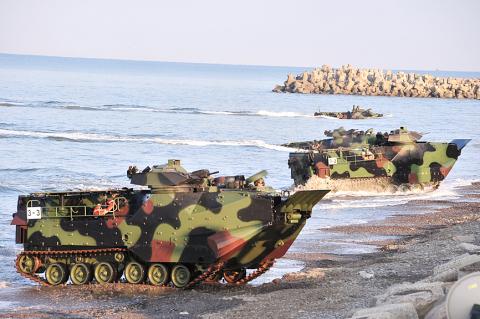Deliveries of US amphibious assault vehicles have been delayed, with supplier the US military citing technical difficulties.
In a bid to improve the nation’s amphibious assault capabilities, 36 AAV-7A1s were purchased from the US, with the first shipment to arrive in the second half of this year and the remainder to be received by the end of 2019.
Sources said that even though payment for the first shipment has been sent, the vehicles are to be delayed until 2020.

Photo: Tsai Tsung-hsien, Taipei Times
One source said the military has been in contact with the US in an attempt to resolve the situation, expressing concern that LVTP-5 amphibious vehicles in service have exceeded their useful life and that continued use would compromise Taiwan’s amphibious assault capabilities, but the US has remained resolute in its position.
The US cited technical difficulties for the delay, saying that it is waiting on other orders.
Military officials said they had settled the issue with the US in 2013, adding that the delay might be because of a political issue.
“The AAV-7A1 plays a pivotal role in modern amphibious warfare. Whether in defense of the perimeter of the Pratas Islands [Dongsha Islands, 東沙群島] or Itu Aba Island [Taiping Island, 太平島], in a mission to safeguard Taiwan’s southern coast or the outlying islands of Kinmen and Matsu, or even in conducting rescue missions following major natural disasters, the AAV-7A1 plays a crucial role,” the source said.
“Delaying shipment of the 36 vehicles will be a major blow to the military’s ability to maintain combat readiness,” the source said.
Navy Command Headquarters yesterday said that “because the US has to conform to a production schedule that allows it to complete several orders simultaneously, shipments will be postponed.”
The navy said that the shipment would be accomplished in two installments, with 24 units arriving in 2020 and the remainder in 2021, adding that it would make amendments to its investment network because of the delay.
The navy has used the LVTP-5 in amphibious landing exercises, but as the vehicles are beyond their service lifespan, finding replacement parts has become increasingly difficult.
In 2006, the navy commissioned the US to produce 54 AAV-7A1s to replace its outdated fleet.
A military official said that although it has already procured 54 AAV-7A1s, that is far from its target, which is to procure 36 more.
The navy plans to use four of the AAV-7A1s as command vehicles, while two are to be assigned for use in disaster relief operations.
The official said the 36 vehicles cost NT$5.3 billion (US$165.26 million), with the purchase contract signed by both sides on May 12 and funds transferred on June 24.
“It was completely unexpected that the US would suddenly announce a three-and-a-half-year delay. The sudden, unexpected nature of the decision was a great shock to the military — we are unable to accept this turn of events,” the official said.

The US government has signed defense cooperation agreements with Japan and the Philippines to boost the deterrence capabilities of countries in the first island chain, a report by the National Security Bureau (NSB) showed. The main countries on the first island chain include the two nations and Taiwan. The bureau is to present the report at a meeting of the legislature’s Foreign Affairs and National Defense Committee tomorrow. The US military has deployed Typhon missile systems to Japan’s Yamaguchi Prefecture and Zambales province in the Philippines during their joint military exercises. It has also installed NMESIS anti-ship systems in Japan’s Okinawa

‘WIN-WIN’: The Philippines, and central and eastern European countries are important potential drone cooperation partners, Minister of Foreign Affairs Lin Chia-lung said Minister of Foreign Affairs Lin Chia-lung (林佳龍) in an interview published yesterday confirmed that there are joint ventures between Taiwan and Poland in the drone industry. Lin made the remark in an exclusive interview with the Chinese-language Liberty Times (the Taipei Times’ sister paper). The government-backed Taiwan Excellence Drone International Business Opportunities Alliance and the Polish Chamber of Unmanned Systems on Wednesday last week signed a memorandum of understanding in Poland to develop a “non-China” supply chain for drones and work together on key technologies. Asked if Taiwan prioritized Poland among central and eastern European countries in drone collaboration, Lin

NO CONFIDENCE MOTION? The premier said that being toppled by the legislature for defending the Constitution would be a democratic badge of honor for him Premier Cho Jung-tai (卓榮泰) yesterday announced that the Cabinet would not countersign the amendments to the local revenue-sharing law passed by the Legislative Yuan last month. Cho said the decision not to countersign the amendments to the Act Governing the Allocation of Government Revenues and Expenditures (財政收支劃分法) was made in accordance with the Constitution. “The decision aims to safeguard our Constitution,” he said. The Constitution stipulates the president shall, in accordance with law, promulgate laws and issue mandates with the countersignature of the head of the Executive Yuan, or with the countersignatures of both the head of the Executive Yuan and ministers or

CABINET APPROVAL: People seeking assisted reproduction must be assessed to determine whether they would be adequate parents, the planned changes say Proposed amendments to the Assisted Reproduction Act (人工生殖法) advanced yesterday by the Executive Yuan would grant married lesbian couples and single women access to legal assisted reproductive services. The proposed revisions are “based on the fundamental principle of respecting women’s reproductive autonomy,” Cabinet spokesperson Michelle Lee (李慧芝) quoted Vice Premier Cheng Li-chiun (鄭麗君), who presided over a Cabinet meeting earlier yesterday, as saying at the briefing. The draft amendment would be submitted to the legislature for review. The Ministry of Health and Welfare, which proposed the amendments, said that experts on children’s rights, gender equality, law and medicine attended cross-disciplinary meetings, adding that